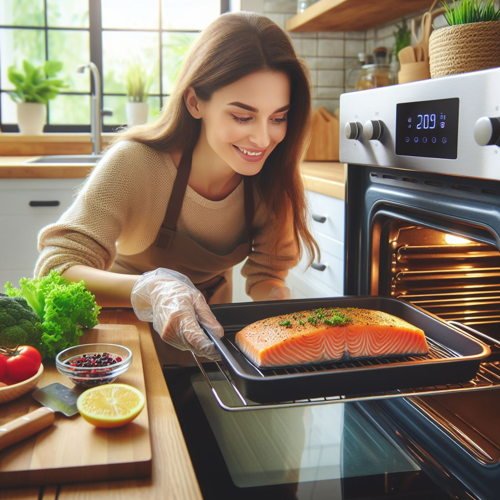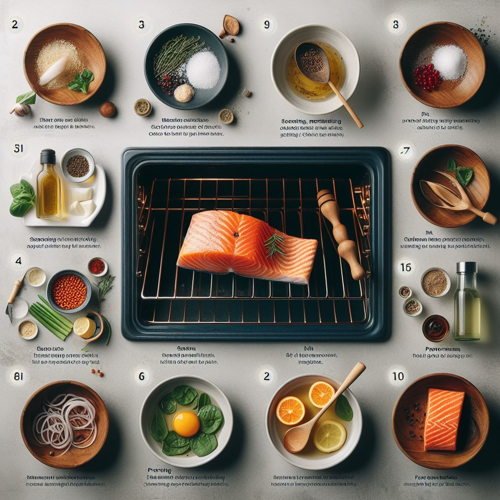Have you ever wanted to wow your guests with a mouthwatering salmon dish but felt apprehensive about cooking fish? Fear not, as we have the solution for you! With our step-by-step guide, you will learn how to perfectly cook salmon in a convection oven, achieving a flaky, moist, and flavorful result every time. Say goodbye to the fear of overcooking or undercooking your salmon as we walk you through the process from start to finish. From seasoning to baking, we’ve got you covered. So let’s get cooking!
Key Takeaways:
- Elevated Flavor: Cooking salmon in a convection oven allows for even browning and crispy exteriors, enhancing the flavor and texture of the fish.
- Time and Energy Efficient: Convection ovens cook food faster and at lower temperatures, saving time and reducing energy costs.
- Healthy Cooking Option: Using a convection oven to cook salmon requires less added fats or oils, making it a healthier cooking method compared to frying or sautéing.

Preparing the Salmon
While cooking salmon in a convection oven may seem intimidating, it’s actually a straightforward process that yields delicious results. First things first, you need to properly prepare the salmon before it goes into the oven. This chapter will guide you through the essential steps to ensure your salmon turns out perfectly cooked and full of flavor.
Choosing the Right Salmon
Choosing the right salmon is crucial for a successful cooking outcome. Wild-caught salmon is generally considered to be higher in quality than farm-raised salmon, as it tends to have a better flavor and texture. Look for salmon fillets that are firm, moist, and free of any off-putting odors.
Additionally, it’s important to consider sustainability when selecting salmon, so be sure to check for eco-friendly certifications such as the Marine Stewardship Council’s (MSC) label.
Preparing the Salmon for Cooking
Salmon should be thawed before cooking if frozen. Once thawed, pat the salmon dry with paper towels to remove any excess moisture. If desired, you can marinate the salmon with olive oil, lemon juice, and herbs to enhance its flavor. For a crispy skin, make sure the salmon skin is dry before cooking.
Salmon is a rich source of omega-3 fatty acids and protein, making it a nutritious and delicious option for any meal. You may amaze your dinner guests with a delicious entrée by choosing the perfect salmon and cooking it properly.

Cooking Techniques
The key to cooking salmon in a convection oven lies in mastering a few essential techniques. With the right approach, you can achieve perfectly cooked, flavorful salmon every time.
How-to: Seasoning Your Salmon for Optimal Flavor
Salmon is a versatile fish that pairs well with a variety of seasonings. Before cooking, pat the salmon dry with paper towels to remove any excess moisture. This will help the seasonings adhere to the fish and create a delicious crust.
For a simple yet flavorful option, try seasoning the salmon with a mixture of salt, pepper, and a squeeze of fresh lemon juice. Alternatively, you can experiment with different herbs and spices, such as dill, garlic powder, or smoked paprika, to elevate the flavor profile of the fish.
To further enhance the taste, consider marinating the salmon in a mixture of soy sauce, honey, and minced ginger for an Asian-inspired twist. Let the salmon sit in the marinade for at least 30 minutes before cooking to allow the flavors to penetrate the fish.
How-to: Setting Your Convection Oven
Setting your convection oven to the right temperature is crucial for achieving tender and moist salmon. Preheat the oven to 375°F (190°C) and place the salmon on a parchment-lined baking sheet. This will prevent the fish from sticking to the pan and make cleanup a breeze. If your oven has a convection setting, be sure to activate it to ensure even cooking and optimal results.
How to: Keep an eye on the salmon while it’s in the oven, as overcooking can result in dry and tough fish. A general rule of thumb is to cook the salmon for 10–12 minutes per inch of thickness. Use a meat thermometer to check for doneness; the internal temperature of the salmon should reach 145°F (63°C).

Factors Influencing Cooking Time and Texture
Now that you’ve decided to cook salmon in a convection oven, it’s important to understand the factors that influence the cooking time and texture of your dish. This knowledge will help you achieve the perfect salmon every time. Here are some key factors to consider:
- Thickness of the salmon
- Reaching the optimal temperature
- Moisture content
This understanding will ensure that you have full control over the outcome of your salmon, whether you prefer it rare, medium, or well-done.
Thickness of the Salmon
With salmon, the thickness of the fillet plays a crucial role in determining the cooking time and overall texture. Thicker cuts of salmon will require a longer cooking time, whereas thinner cuts will cook much faster. It’s important to take this into account when planning your meal, as overcooking can result in dry and tough salmon, while undercooking can lead to a raw and unpleasant texture.
The Importance of Preheating Your Convection Oven
The importance of preheating your convection oven cannot be overstated when cooking salmon. Preheating ensures that the oven reaches the desired temperature before you introduce the salmon, resulting in more consistent and predictable cooking. It also helps in achieving that perfect crispy exterior while maintaining the juiciness inside. Skipping the preheating step can lead to uneven cooking and affect the overall texture of your salmon.
Cooking salmon in a convection oven without preheating can lead to longer cooking times and potential moisture loss, ultimately impacting the final outcome of your dish. Preheating your convection oven is a simple yet crucial step in achieving the desired texture and flavor in your salmon.

Additional Tips for Perfectly Cooked Salmon
Despite the simplicity of cooking salmon in a convection oven, there are a few tips that can help ensure your fish turns out perfectly every time:
- Use a meat thermometer to check the internal temperature, which should reach 145°F for a perfectly cooked salmon.
- Consider marinating the salmon for added flavor, or brush it with a glaze before cooking for a caramelized finish.
- Pat the salmon dry before cooking to ensure a crispy exterior.
- Allow the salmon to rest for a few minutes after cooking to ensure juiciness.
- Choose high-quality salmon for the best results.
This will help you achieve restaurant-quality salmon right in your own kitchen.
How to Tell When Your Salmon is Done
To ensure your salmon is perfectly cooked, look for a flaky texture and an opaque color. The flesh should easily flake with a fork, and the center of the salmon should be slightly translucent when done. It’s better to slightly undercook than to overcook, as the salmon will continue to cook slightly once removed from the oven.
Pairing Suggestions and Serving Ideas
Serve nicely cooked salmon with a crisp white wine like Sauvignon Blanc or a light red wine like Pinot Noir. Serve salmon with a fresh salad or roasted vegetables to compliment its rich flavor. A delicious salmon recipe relies on high-quality fish and simple preparation to highlight its characteristics.

FAQ
Q 1: Why is cooking salmon in a convection oven beneficial?
Ans: Salmon cooked in a convection oven is tender and crispy due to equal heat distribution.
Q 2: What temperature should I set the convection oven to for cooking salmon?
Ans: Preheat the convection oven to 375°F (190°C) for optimal results when cooking salmon.
Q 3: How long does it take to cook salmon in a convection oven?
Ans: Generally, it takes about 12–15 minutes to cook salmon in a convection oven, depending on the thickness of the fillet.
Q 4: What are some recommended seasonings or marinades for cooking salmon in a convection oven?
Ans: Lemon, garlic, dill, thyme, and rosemary are popular seasonings for salmon. You can also use a simple marinade of olive oil, soy sauce, and honey for added flavor.
Q 5: How do I know when the salmon is done cooking in a convection oven?
Ans: The salmon is done cooking when it reaches an internal temperature of 145°F (63°C) and easily flakes with a fork. It should appear opaque and moist.
 https://bistrovivant.com is a participant in the Amazon Services LLC Associates Program, an affiliate advertising program designed to provide a means for website owners to earn advertising fees by advertising and linking to Amazon (.com,.co.uk,.ca, etc.) and any other website that may be affiliated with the Amazon Service LLC Associates Program. As an Amazon Associate, I earn from qualifying purchases.
https://bistrovivant.com is a participant in the Amazon Services LLC Associates Program, an affiliate advertising program designed to provide a means for website owners to earn advertising fees by advertising and linking to Amazon (.com,.co.uk,.ca, etc.) and any other website that may be affiliated with the Amazon Service LLC Associates Program. As an Amazon Associate, I earn from qualifying purchases.
